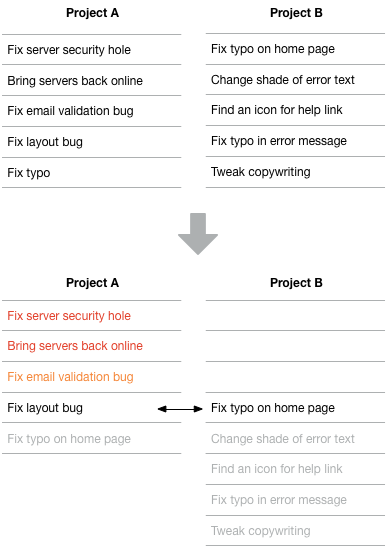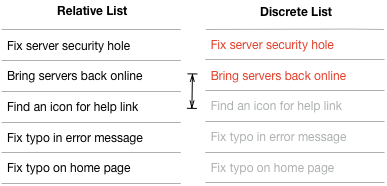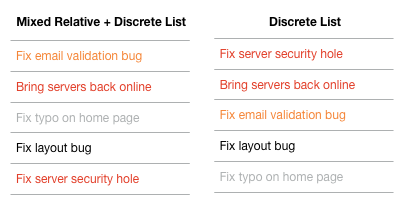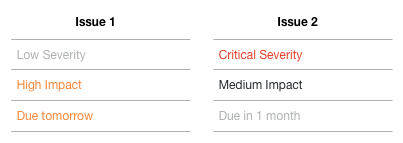Relative vs. Discrete
With priority, there’s a dichotomy between relative and discrete. In the case of relative priorities where you use an ordered list of items with the highest priority at the top and the lowest priority at the bottom, you gain the benefit of having a simple model. You are forced to say that one item is indeed more important than the next item. This is a good thing because it’s impossible for anyone to say that everything is critical. However, that’s where the benefits end.

With relative priorities outside of the context of the list, you don’t really have way of understanding a given item’s priority because you’re missing the context. Similarly, if you’re comparing priorities across two separate lists, there’s no way to accurately gauge equivalency. 1
You could use a number representing the item’s place in the list in order to provide a quantitative measure, but that only communicates order. A 6 on one list may still not be equivalent to a 6 on another list. Additionally, if the priority for that item increases, you can only rearrange it in the list. You can’t explicitly change its actual priority.

Furthermore, if you have a list with only two items, you have no way of knowing if those items are truly important or just nice-to-have. They only have a priority relative to each other. With a relative list, it’s also difficult to recognize significant gaps in priority between two items on the list. For instance, if you have two critical items followed by three trivial items, you can’t tell at a glance. 2

One could use both relative and discrete together, but then you end up with twice as much work to, at best, create a conflicting sense of priority. 3 Most likely, you’ll spend time keeping the two in sync in which case, you’re only adding more work, not more insight.
Discrete priorities have the benefit of being truly atomic. It can be expressed with a single word outside the context of a list. The discrete priority provides meaning. You don’t have to have an exact picture of all other issues to assess its priority. Of course, choosing a single priority isn’t quite so simple and takes some careful consideration. So let’s talk about that.
Determining Priority
There are numerous bits that can influence the priority of a given item. These don’t all apply equally to every type of issue, but they do all factor in at some level. Each of these is a consideration at one level or another with almost any item.
- Urgency Does anything change if this is done right now or a month from now?
- Severity - Is the entire application broken or is this just a typo?
- Impact - Does this affect 1 person or 100?
- Workaround - Is there a temporary way for people to accomplish their goal without this?
- Risk - What’s the likelihood that we make things worse if we rush?
- Due dates - Are there key dates that can’t be missed due to external dependencies?
- Relativity - How does this fit in with our other work? i.e. If everything is important, nothing is.
- Resources Available - How much time/money/materials can we apply to this?
- Resources Required - How much time/money/materials would we need in order to do this?
We could, in theory, record each of these data points for each and every issue, but the primary value in that would be if you let the system calculate the resulting priority. Unfortunately, synthesizing this data into a definitive priority requires intuition and judgement that computers just don’t have.
With multiple facets for prioritization, it also becomes easy to create conflicting scenarios. Imagine having a low severity, high impact item that’s due tomorrow and a high severity, low impact item that’s due a month from now. 4 Which one do you work on? Which one of the facets is the trump card? Severity? Impact? Due date? Now, instead of clear priorities, things have gotten messy and confusing.

And none of this considers what a nightmare it would be fill out and maintain those values as things changed. It’s simply not practical. The simplest solution is to leave those considerations to humans and populate a single definitive priority field.
One priority to rule them all.
There are dozens of ways to handle prioritization. They each have benefits and tradeoffs, but after years of research, consideration, and chats with customers, we’re big believers that a single priority field is the most flexible and resilient of all approaches to managing priority.